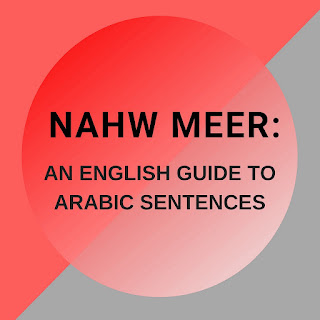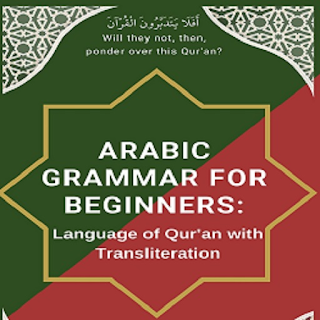Nahw Meer English: 2.3 – Non-Declinable Noun
Section 2.3 – Non-Declinable Noun فَصْلٌ ٢.٣ – اَلْاِسْمُ الْغيرُ الْمُتَمَكِّنُ |
Non-Declinable Nouns اَلْاِسْمُ الْغيرُ الْمُتَمَكِّنُ are of eight types:
First: Personal Pronouns اَلْمُضْمَرَاتُ: As in أَنَا, ضَرَبْتُ,إِيّايَ, ضَرَبَنِيْ, لِيْare for both masculine and feminine gender Pronouns for the speaker.
There are seventy Personal Pronouns اَلْمُضْمَرَاتُ:
1) Attached Nominative مَرْفُوْعُ الْمُتَّصِلِ: There are 14:
ضَرَبْتُ ضَرَبْنَا ضَرَبْتَ ضَرَبْتُمَا ضَرَبْتُمْ ضَرَبْتِ ضَرَبْتُمَا ضَرَبْتُنَّ ضَرَبَ ضَرَبَا ضَرَبُوْا ضَرَبَتْ ضَرَبَتَا ضَرَبْنَ
2) Detached Nominative مَرْفُوْعُ الْمُنْفَصِلِ: There are 14:
اَنَا نَحْنُ أَنْتَ أَنْتُمَا أَنْتُمْ أَنْتِ أَنْتُمَا أَنْتُنَّ هُوَ هُمَا هُمْ هِيَ هُمَا هُنَّ
3) Attached Accusative مَنْصُوْبُ الْمُتَّصِلِ: There are 14:
ضَرَبَنِي ضَرَبَنَا ضَرَبَكَ ضَرَبَكُمَا ضَرَبَكُمْ ضَرَبَكِ ضَرَبَكُمَا ضَرَبَكُنَّ ضَرَبَهُ ضَرَبَهُمَا ضَرَبَهُمْ ضَرَبَهَا ضَرَبَهُمَا ضَرَبَهُنَّ
4) Detached Accusative مَنْصُوْبُ الْمُنْفَصِلِ: There are 14:
إِيَّايَ إِيَّانَا إِيَّاكَ إِيَّاَكُمَا إِيَّاَكُمْ إِيَّاكِ إِيَّاكُمَا إِيَّاكُنَّ إِيَّاہُ إِيَّاهُمَا إِيَّاهُمْ إِيَّاهَا إِيَّاهُمَا إِيَّاهُنَّ
5) Attached Genitive مَجْرُوْرُ الْمُتَّصِلِ: There are 14:
لِي لَنَا لَكَ لَكُمَا لَكُمْ لَكِ لَكُمَا لَكُنَّ لَهٗ لَهُمَا لَهُمْ لَهَا لَهُمَا لَهُنَّ
6) There are no Detached Genitive مَجْرُوْرُ الْمُنْفَصِلِ Pronouns.
See the table below for details on these 70 inflections:
Table 1 – Pronoun Inflections
| Flexibility إِعْرَابٌ | Gender جِنْسٌ | Number عَدَدٌ | Attached Nominative مَرْفُوْعُ الْمُتَّصِلِ | Detached Nominative مَرْفُوْعُ الْمُنْفَصِلِ | Attached Accusative مَنْصُوْبُ الْمُتَّصِلِ | Detached Accusative مَنْصُوْبُ اَلْمُنْفَصِلِ | Attached Genitive مَجْرُوْرُ الْمُتَّصِلِ | Attached Genitive مَجْرُوْرُ الْمُنْفَصِلِ |
| Speaker مُتَكَلِّمٌ | Male/ Female مُذَكَّرٌ/ مَؤَنَّثٌ | Single | ضَرَبْتُ | أَنَا | ضَرَبَنِي | إِيَّايَ | لِي | None |
| Dual/Plural | ضَرَبْنَا | نَحْنُ | ضَرَبَنَا | إِيَّانَا | لَنَا | None | ||
| Present حَاضِرٌ | Male مُذَكَّرٌ | Single | ضَرَبْتَ | أَنْتَ | ضَرَبَكَ | إِيَّاكَ | لَكَ | None |
| Dual | ضَرَبْتُمَا | أَنْتُمَا | ضَرَبَكُمَا | إِيَّاكُمَا | لَكُمَا | None | ||
| Plural | ضَرَبْتُمْ | أَنْتُمْ | ضَرَبَكُمْ | إِيَّاكُمْ | لَكُمْ | None | ||
| Female مَؤَنَّثٌ | Single | ضَرَبْتِ | أَنْتِ | ضَرَبَكِ | إِيَّاكِ | لَكِ | None | |
| Dual | ضَرَبْتُمَا | أَنْتُمَا | ضَرَبَكُمَا | إِيَّاكُمَا | لَكُمَا | None | ||
| Plural | ضَرَبْتُنَّ | أَنْتُنَّ | ضَرَبَكُنَّ | إِيَّاكُنَّ | لَكُنَّ | None | ||
| Absent غَائِبٌ | Male مُذَكَّرٌ | Single | ضَرَبَ | هُوَ | ضَرَبَهُ | اِيَّاہُ | لهٗ | None |
| Dual | ضَرَبَا | هُمَا | ضَرَبَهُمَا | إِيَّاهُمَا | لَهُمَا | None | ||
| Plural | ضَرَبُوْا | هُمْ | ضَرَبَهُمْ | إِيَّاهُمْ | لَهُمْ | None | ||
| Female مَؤَنَّثٌ | Single | ضَرَبَتْ | هِيَ | ضَرَبَهَا | إِيَّاهَا | لَهَا | None | |
| Dual | ضَرَبَتَا | هُمَا | ضَرَبَهُمَا | إِيَّاهُمَا | لَهُمَا | None | ||
| Plural | ضَرَبْنَ | هُنَّ | ضَرَبَهُنَّ | إِيَّاهُنَّ | لَهُنَّ | None |
Second: The demonstrative Pronouns أَسْمَاءُ الْإِشَارَةِ[1]:
ذَا، ذَانِ، ذَيْنِ، تَا، تِيْ، تُهْ، ذِہْ، ذِهِي، تِهِي، تَانِ، تَيْنِ، أُوْلَاءِ بِالْمَدِّ، أُوْليٰ بِالْقَصْرِ
Here, for example, ذَا in هٰذَا and ذَانِin هٰذَانِ.
See the table below for more details.
Table 2 – Demonstrative Pronoun Near and Far
| | Genderجِنْسٌ | Single مُفْرَدٌ | Dualمُثَنّٰى | Plural جَمْعٌ | |
| Nominative رَفْعٌ | Accusative/Genitive نَصْبٌ/جَرٌّ | ||||
| Nearقَرِيْبٌ | Male مُذَكَّرٌ | هٰذَا This | هٰذَانِ These two | هٰذَيْنِ These two | هٰؤُلٓاءِ These |
| Female مَؤَنَّثٌ | هٰذِہِ This | هَاتَانِ These two | هَاتَينِ These two | ||
| Far بَعِيْدٌ | Male مُذَكَّرٌ | ذٰلِكَ That | ذٰنِكَ Those two | ذَيْنِكَ Those Two | اُوْلٰٓئِكَ Those |
| Female مَؤَنَّثٌ | تِلْكَ That | تَانِكَ Those two | تَيْنِكَ Those two | ||
Third: The Relative Pronouns أَسمَاءُالْموصُوْلَةِ:
اَلَّذَيْ، اَللَّذَانِ، اَللَّذَيْنِ، اَلَّذِيْنَ، اَلَّتِيْ، اَللَّتَانِ، اَللَّتَيْنِ، اَلَّاتِيْ، اَلَّوَاتِيْ، مَا، مَنْ، أَيٌّ، أَيَّةٌ
Note that Al-Quran has used two lams for dual pronouns.
See the table below for the details:
Table 3 – Relative Pronouns
| | Single مُفْرَدٌ | Dualمُثَنّٰى | Plural جمْعٌ | |
| Nominative رَفْعٌ | Accusative/Genitive نَصْبٌ/جَرٌّ | |||
| Maleمُذَكَّرٌ | اَلَّذَيْ The one who | اَللَّذَانِ Those two who | اَللَّذَيْنِ Those two who | اَلَّذِيْنَ Those who |
| Femaleمَؤَنَّث | اَلَّتِيْ The one who | اَللَّتَانِ Those two who | اَللَّتَيْنِ Those two who | اَلَّاتِيْ، اَلَّوَاتِيْ Those who |
- اَلْأَلِفُ وَالَّامُ (اَلْ) meaning اَلَّذِيْ in الْفَاعِلِ اِسْمُ” Actor Noun” فَاعِلٌ and اِسْمُ الْمَفْعُوْلِ ” Object Noun” as in اَلضَّارِبُ meaning “the one who hit” and اَلْمَضْرُوَبُ meaning “the one who was hit”.
- ذُوْ means اَلَّذِي in the language of Bani Tai, a tribe in Arabia. For example, جَاءَنِيْ الَّذِيْ ضَرَبَكَ is ضَرَبَكَ ذُوْ جَاءنِيْ meaning “the one who hit you, came to me”.
- أَيٌّ and أَيَّةٌ are Flexibleمُعْرَبٌ
Fourth: The Actor Nouns أَسْمَاءُالْأَفْعَالِ. These are of two kinds:
1) With the meaning of Imperative Imperfect Tense Verb اَلْأَمْرُالْحَاضِرُ as in [2]رُوَيْدَ,بَلْهَ, حَيَّهَلْ, هَلُمَّ
2) With the meaning of Past Tense Verb اَلْفِعْلُ الْمَاضِيُّ as in [3] هَيْهَاتَand شَتَّانَ.
Fifth: The Nouns of Sound أَسْمَاءُالْأَصْوَاتِ. These are not permanent Nouns by themselves but they provide reasoning for other meanings as in:
أَحْ أَحْ، اُفْ، بَخَّ، نَخَّ، غَاقَ [4]
Sixth: The adverbs أَسْمَاءُالْظُّرُوْفِ. These are of two kinds:
1) Adverb of Time ظَرْفُ الزَّمَانِ:
إِذْ، إِذَا، مَتٰى، كَيْفَ، أَيَّانَ، أَمْسَ، مُذْ، مُنْذُ، قَطُّ، عَوْضُ، قَبْلُ، بَعْدُ
With meanings from the right: then, then, when, how, when, yesterday, Ago, Ago (also), whenever, whenever (also), before, after.
The last two are Non-Flexible مَبْنيٌّ when they are both Possessed part مُضَافٌ of the Possessive Compound and “Possessor مُضَافٌ إِلَيْهِ” part of the Possessive Compound is skipped مَحْذُوْفٌ and meaning is intended. As Allah SWTSays in The Holy Quran, Surah Ar-Room, Ayah 4:
﴿للهِ الْأَمْرُ مِنْ قَبْلُ وَ مِنْۢ بَعْدُ﴾
meaning “command in all things is for Allah before and after”. Here شَيٍّ كُلَّ meaning “all things” is skipped مَحْذُوْفٌbut the meaning is implied.
2) Adverb of place ظَرْفُ الْمَكَانِ:
حَيثُ meaning “where”, قَدَّامُ meaning “in front of”, تَحْتُ meaning “below” and فَوَقَ meaning “above” with the condition that both are Possessed مُضَافٌ, and Possessor إِلَيْهِ مُضَافٌ is skipped مَحْذُوْفٌ and meaning is intended.
Seventh: The hidden Demonstrative Pronoun أَسْمَاءُالْكِنَايَةِ: As in كَمْ“how many” and كَذَا “so many” and these two are used for counts; كَيْتَand ذَيْتَ are used in conversational speech as in “this and that”.
Eighth: The Structural Compound مُرَكَّبُ الْبِنَائيْ: As in the number أَحَدَ عَشَرَ for eleven. This has been discussed in incomplete اَلْمُرَكَّبُ الْغيْرُ الْمُفِيْدُ.
۞۞۞
[1] These are the non-declinable type nouns.
[2] رُوَيْدَ with the meaning of give respite, بَلْهَ meaning leave , حَيَّهَلْ meaning come,هَلُمَّ meaning come.
[3] هَيْهَاتَmeaning go away, شَتَّانَ meaning parted.
[4] أَحْ أَحْimplies chest pain, اُفْ for regret, بَخَّ for happy, نَخَّ sound for making a camel sit, غَاقَ for a crows sound.





Comments